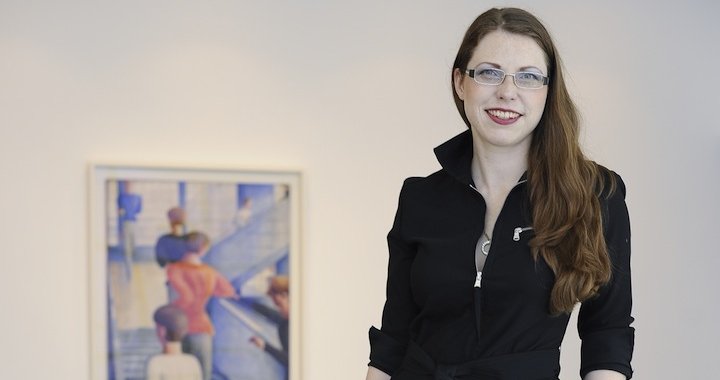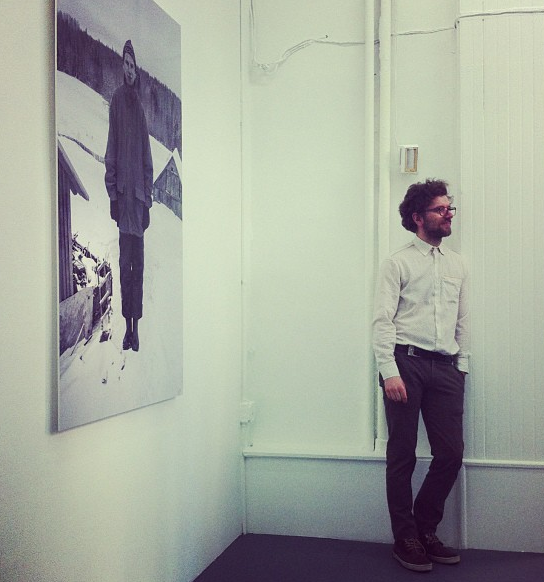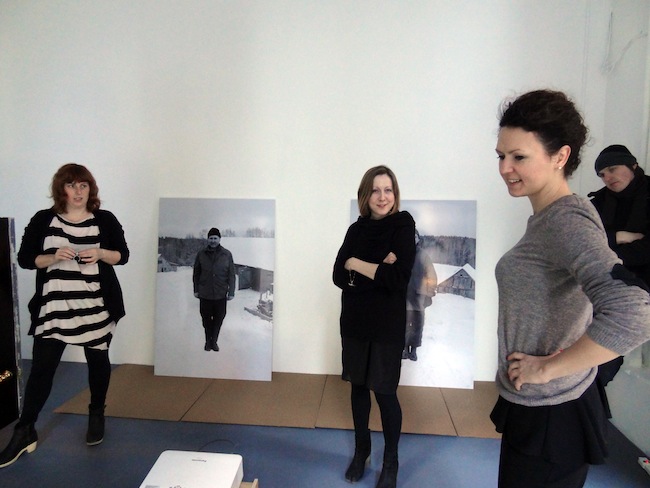
Don’t get Lost in Translation
An interview with Alise Tīfentāle, curator of Latvia's national pavilion at the 55th Venice Biennale
Interviewed by
08/03/2013
Although the first Venice Biennale was held way back in 1895, it is still one of the most powerful global magnets attracting both professionals and lay people who are captivated by contemporary art. Officially opening 1 June, the national pavilions will be open for public perusal all the way through 24 November. This will be a notable year for Latvia at the fair, not the least because of a change in the location of its pavilion; the new spot will be closer to the heart of the art magnet – the Arsenale, in which the biennale's head curator, the youthful Massimiliano Gioni, is putting together the thematic central exhibition. Thoughts are divided on whether or not this will make Latvia's presence more noticeable – or on the contrary, quite invisible – by being so close to the hullabaloo generated by the Arsenale itself. Another novelty for Latvia this year will be the debut of non-Latvian curators co-managing the national pavilion – Anne Barlow and Courtney Finn, from the New York organization Art in General, will be working at Latvia's stand alongside the kim? Contemporary Art Centre and curator Alise Tīfentāle. Latvia's pavilion will feature the artists Krišs Salmanis and Kaspars Podnieks, working completely independently from one another, but under the unifying concept titled “North by Northeast”. Thanks to Art in General physically being “across the pond”, so to say, the press conference for the Latvian national pavilion's exhibition was held in New York, on 5 March. And to top it all off, the conference just happened to coincide with the week of the legendary Armory Show's 100 year anniversary (and, of course, the associated teeming masses). Beginning 7 March, the rooms of Art in General are showing the works of Salmanis and Podnieks; New Yorkers, and all guests of the city, will have the whole of the month to view the creations of the Latvian artists. Alise Tīfentāle herself has spent the last two years studying and working in New York, and graciously agreed to an interview about the Latvian exhibition and the meaning of the Venice Biennale today.
How does the introductory exhibition in New York differ from that which will be on view in Venice?
The exhibition at Art in General, from March 5 – 30, will introduce the New York public to the following works by Kaspars Podnieks and Krišs Salmanis: Podnieks' photographs from the series, “Rommel's Dairy, 2013”; and Salmanis' video, “Long Day, 2012” (sound by Steve Roden). Concurrently, both artists will be working on new pieces for the biennale show, under the consolidating title of North by Northeast, which reflects both Latvia's geographical location in relation to Venice, as well as how we would like to position ourselves and Latvia.

Krišs Salmanis next to Kaspars Podnieks' photographs in New York. Photo: Art in General
What happens to the ambitions of the single curator, when one has to work with other curators?
I don't know what the “ambitions of the curator” are. The job of the curator, in any case, is a team job; in the whole world, there may be just a handful of visionaries who can afford to not take anyone else into account, and who can just bring their own ideas to life. In our case, the whole project is based on cooperation and dialog. This is a collective effort.
Tell me about working with Art in General. How do you divide your duties?
There's a much larger team with the Latvian exhibition. First of all, there's the kim? Contemporary Art Centre – the organizer and coordinator of the whole project. The exhibition has three co-curators – I have the honor to be working with Anne Barlow and Courtney Finn from Art in General. In our collaboration, the keyword is “dialog” – both with the artists, and among ourselves. This is the first instance of foreign experts taking part in the creation of Latvia's pavilion, and in my opinion, there's a future in this method. Because even in the current day, the world of Latvian art is so microscopic and closed-off that it's virtually unapproachable to the outsider. Just like a piece of text written in Latvian, but without a translation. But the Venice Biennale, and other similar international events, are oriented towards this cosmopolitan and globally-thinking audience of art professionals and interested individuals who need this “translation” from the Latvian language – both metaphorically and literally. In working together with Anne and Courtney, we each put to use our different experiences and knowledge.
How do you explain the curators of Art in General taking an interest in representing Latvia's art? And what is your opinion on the trend of foreign artists, or curators, appearing in the exhibitions of national pavilions?
Art in General has been working with Eastern European countries since 2001 (with the Baltic countries joining in just recently), organizing residency programs for artists and promoting the exchange of ideas and the creation of new art works. As a non-profit art organization working in the name of ideals, Art in General is a wonderful example of how much can be achieved in this New York art world, which still is mostly commercial in nature.
In terms of foreign participants in national exhibitions, 2007 comes to mind, when the Ukrainian pavilion featured the works of British artists Sam Taylor-Wood and Mark Titchner, and the German photographer Juergen Teller. Theoretically, the works were conceptually linked to the issue of modern-day Ukrainian identity. And there's no lack of similar examples. This year, for instance, the Estonian pavilion is being curated by Adam Budak. And so forth. I believe that this direction of development has perspective, because this notion of “national art” – which is an attempt at keeping alive the 19th century principle of national pavilions showcasing industrial achievements at international fairs – is antiquated, old-fashioned, and in need of an overhaul.
How does your experience of working in the context of New York come into play during your curating of the Latvian pavilion's exhibit at the Venice Biennale?
Over the last two years, both my doctoral studies and my professional work – in an artistic context in New York – have intrinsically changed my view of Latvia's art history and today's situation. In working on academic publications that deal with Latvia's art history, and in speaking with American art historians and professors, I frequently have to explain that, which in Latvia is self-evident, or is never even discussed. Having a good understanding of the art scene in today's Latvia – in which I have been active for over ten years – and now finding myself outside of it, and looking in at it from the sidelines, this is exactly what is necessary for a rational view, analysis and critique of the situation; a certain distancing of oneself from everything personal which, in my opinion, is linked too closely with the professionals in Latvia's art scene, and the critique thereof. By overly honoring or praising an artist because of his charming personality, the critics often forget to actually look at the works themselves.
How do you rate the new location for Latvia's pavilion?
I think that the placement of the pavilion in the Arsenale is simply brilliant, from a strategic viewpoint. Most of the visitors to the fair are in Venice for only a limited time – a couple of days – and they focus, first of all, on the main attractions – the Arsenale and the Gardens (Giardini) – and don't even bother to look for the rest of the national pavilions that are scattered throughout the city, especially if they don't contain any world-famous artists. This year is going to be completely different!

From the Left: Courtney Finn, Zane Onckule, Zane Čulkstēna and Kaspars Podnieks, preparing the exposition at the Art in General exhibition space. Photo: Krišs Salmanis
Does the Venice Biennale change at all? Is it still the “Olympic Games” of the art world?
Changes are mainly felt in terms of content because every year, everyone talks about how brilliantly, or conversely – how poorly, the main curator set up his exhibition. The rest is just a colorful backdrop. In terms of format, it would be more fitting to talk about stagnation – which in this case, is perhaps an indicator of the condition in which the global art world finds itself. The rules are set by the market and a long line of superstars and recognized artists; and art critique and theory – with amazing obedience – largely follows these rules. The leading art critics from all of the established publications know very well that besides going to the Arsenale, a visit to the US and Italian pavilions, perhaps also the German, French and UK pavilions, is obligatory; only then, if they still have the time and energy, they may take a quick look at something new and unknown. But it is absolutely clear that the reviews will mainly feature the names of the most famous artists, i.e., the most important names in the art market. And it is just as clear that they will be mentioned only because of the fact that they are famous, and it frequently has nothing to with how good or bad their art is.
Could the Venice Biennale serve Latvia's artists as a sort of stepping stone for entering the world art market?
Entering the market has not been, and is not, the main objective of Latvia's national exhibition. That is something that would, of course, be good for the artist's career – if they managed to form a working relationship with a successful commercial gallery in the West. But in terms of the biennale, we should, firstly, hope for a mention of the artists and their works in the pages of prestigious and professional art publications.
What do you think of Massimiliano Gioni's concept for the Arsenale's main exhibition?
Gioni's conceptions are always fascinating, well-formulated and exciting, but at the same time, they often tend to be superficial. He speaks about an “Encyclopedic Palace” which, first of all, is reminiscent of the Age of Enlightenment, which is when the idea of an “encyclopedia”, as a systematized and rationally organized aggregate of human knowledge, was born. Rationalization and intellectualism are good instruments, but everything depends on motivation and how it is used. In any case, it is admirable that Gioni defends, and gladly includes, “the marginalized” and “the outsiders” into the global art movement – including artists from the soviet and post-soviet zones, with whom Western theoreticians always seem to have difficulties. On the other hand, one must remember that Gioni is responsible for the further marginalizing of those who speak in a non-Western art world-vernacular – and as a result, the cannon of Western modern art still stays safe.

Alise Tīfentāle. Photo: Reinis Fjodorovs
Taking into account that all of the artists and curators are already known, which nation's pavilion are you most anticipating to see?
Without a doubt, this year there is only one – Latvia's pavilion.
Does art have a nationality?
At the same time, it does and doesn't. Everything depends on what the art that we are talking about is like, and what your viewpoint is. For example, we Latvians attempt to discuss what it is that makes art “Latvian” – because that is important to us; with it, we want to tell the world something about us. In comparison, we can ask – are there serious and professional discussions going on about what is “American”, “German”, or “Russian” art? In a broader sense, the linking of art and it belonging to a certain nationality is a delicate issue. Historically, yes – there clearly existed Russian constructivism, German expressionism, Mexican social-realism, etc. In modern-day art, there are only individual instances in which it is important to know the ethnicity of the artist – especially when we take into consideration the cosmopolitan specifics of today's art world. Just the fact that an artist hails from an exotic country somewhere on the edge of Europe – that doesn't mean a thing, yet. Neither does the fact that the same artist may be famous and highly regarded in his country – that means nothing on an international scope. But can his art be understood by someone who doesn't speak the language of his tiny home country? – that is the most important question.